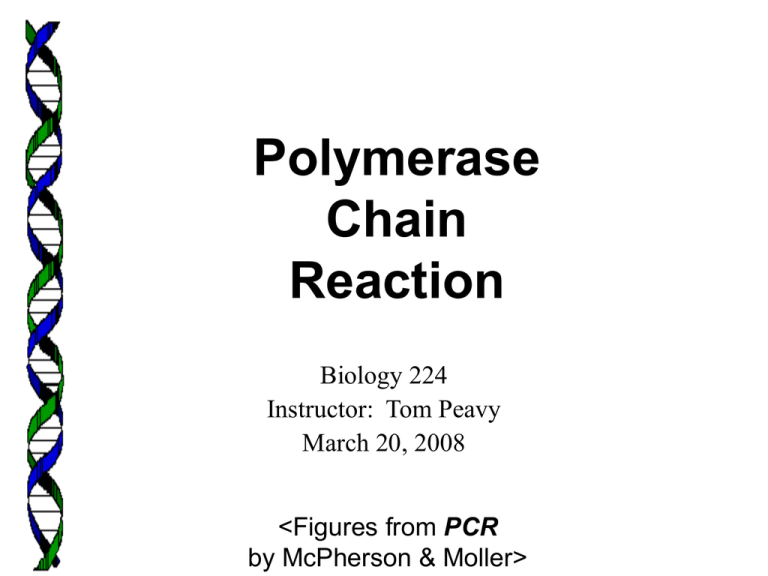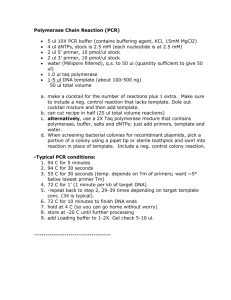PCR
advertisement

Polymerase Chain Reaction Biology 224 Instructor: Tom Peavy March 20, 2008 <Figures from PCR by McPherson & Moller> PCR= Polymerase Chain Reaction • • • • • • “DNA photocopier” integral tool for molecular biologists work horse versatile (many applications) not difficult to perform technically fast • Kary Mullis of Cetus Corp invented PCR in 1983 (Klenow fragment of DNA pol I) • First paper describing the use of Taq polymerase was in 1988 (Saiki et al., 1988) • PCR patent issues involving Taq polymerase PCR applications • Cloning cDNAs and RAPD • Cloning genes • Real-time PCR • PCR mutagenesis • PCR probe generation for hybridization • Population sampling and genotyping • Genomic fingerprinting RAPD-PCR multiplex-PCR PCR-VNTRs Micro- and Minisatelline repeat-PCR • Diagnostic PCR (detection of pathogens, GMOs, etc.) PCR components Template DNA Primers dNTPs (water, buffer) Thermostable polymerase 1) Template DNA is denatured (Denaturation phase; 94C) 2) Primers allowed to anneal to template; Tm of primers is important (Annealing phase; variable temperature) 3) Increase temperature to optimum for thermostable polymerase (Elongation phase; 68-72C) 4) Repeat the whole cycle starting at step 1 PCR Kinetics Early cycles: primers act like probes searching for complementary Sequences on template DNA Mid cycles: amplication process is is fully underway with an exponential accumulation of amplimers Late cycles: reagents are limiting and Amplification is suboptimal Sources of Template DNA Genomic DNA RNA isolation and cDNA Plasmid, bacteriophage, cosmid and artifical chromosome DNA Pathological and forensic samples Archaeological samples Template amount -very sensitive technique (don’t need much target template) but the amount of template is likely to require optimization (generally <1 nanogram of cloned template and up to a microgram of genomic DNA are used) -relative amount of target can be increased (e.g. choose cDNA library where target should be expressed in large amounts) Technical Difficulties Mispriming – primers anneal to alternate sites and not to “correct” or targeted site Needle-in-a-haystack (Template in limited amounts) Mismatches allowed internally if annealing temperature is low (below Tm) Misprimed PCR products will continue to be amplified (PCR primers are incorporated into the amplimer at the terminal end and will thus serve as a perfect match for future PCR cycles; large amounts of PCR product accumulate if in it occurs in the early cycles) PCR of non-specific sequences or misprimed products leads to either smeary gels or unexpected amplimers sizes Artifactual products on agarose gels can arise from Primer-Dimer formation Contamination Problems Carry-over contamination prior PCR products, clones, or samples with DNA in general (e.g. cell lysates, genomic or plasmid DNA preparations, etc) can enter the PCR tube and serve as potential template -most often due to aerosol from pipetteman Other template contamination can be due to: - floating debris (circulation/vents) -laboratory surfaces -tissue from self or others (e.g. skin, hair) -solution contamination Preventative: aerosol-free tips (cotton plugs), UV irradiation, Designated PCR set-up area, gloves, premixes, aliquots of reagents Optimization of PCR To improve specificity: template quality optimize concentrations of Mg2+, other ions, primers, dNTPs and polymerase efficient denaturation, high annealing temps, and fast ramping rates limiting number of cycles and their length PCR strategies (e.g. touchdown PCR, hot start PCR nested PCR) Primer design Magnesium ions are critical -Magnesium ion concentration often needs optimization exists as dNTP-Mg2+ complexes, interacts with DNA backbone influences activity of Taq polymerase; MgCl2 is used in buffer to adjust concentrations Between 0.5 and 5mM is generally used (1.5 mM common) Low concentrations tend to have low yields of PCR product High concentrations tend to reduce the fidelity of Taq polymerase and lead to amplification of non-specific products NaCl or KCl concentrations also can be optimized To enhance for efficient denaturation, high annealing temps, and fast ramping rates: Use quality PCR machines (may not effectively reach temperatures or takes long time to ramp) Use thin walled PCR tubes Use Polymerase with High fidelity Taq polymerase (from thermophilic bacterium Thermus aquaticus) = 94 kDa protein with 2 catalytic properties 1. 5’3’ DNA polymerase (elongates 50-60 nucleotides/second) 2. 5’3’ exonuclease (removes nts in front of growing strand) Recombinant versions of Taq (enhanced for either purification or performance) Lacks 3’5’ exonuclease activity Fidelity of Taq or error rate is: 1 base misincorporation per 104 nucleotides polymerized for a 400 bp fragment amplied 106 fold (=20 cycles) results in in about 33% of the products carrying a mutation (thus should sequence several PCR amplimers to determine consensus) Proofreading DNA polymerases (= those that contain 3’5’ exonuclease activity) Proofreading ability is due to the capacity of the enzyme to discriminate between whether the nucleotide at the 3’ OH of an extending strand is correctly or incorrectly paired with the template strand Generally these enzymes are even more thermostable and tolerant of buffer conditions However, could chew up mismatched 3’ primer ends also (‘nibbling’) Increases fidelity about 5-12 depending on enzyme Examples: Vent®, DeepVent®, Tli (Thermoccocus litoralis), Pfu (Pyrococcus furiosus), 12 fold Usually leaves blunt ends for cloning rather than overhangs Hot Start PCR Used to overcome non-specific annealing of primers and/or primer-dimer formation prior to the denaturation step (annealed primers will be extended as temperature ramps up to denaturation temp) Cheapest method is to add polymerase after temperature is is above 70C Alternatively can use commercial reagents such as Taq that has an antibody attached so as to prevent polymerase activity until the antibody is denatured (> 70C) Touchdown PCR Used to increase specific PCR products Annealing temperature is set slightly above the Tm of the primers in the early cycles (enhances the chances of specific annealing of primers vs. non-specific) Annealing temperature is gradually lowered in subsequent cycles (e.g. 1C every two cycles) until desired lower limiting annealing temperature is reached Effect is that the target sequences are preferentially amplified in early cycles and then are continued to be amplified exponentially (out competing non-specific targets) Nested PCR Design two outside primers for the first reaction, Then use a portion of the first reaction as template in a second reaction using Internal ‘nested’ primers Annealing Temperature and Primer Design Primer length and sequence are of critical importance in designing the parameters of a successful amplification: the melting temperature of a DNA duplex increases both with its length, and with increasing (G+C) content: a simple formula for calculation of the Tm is: Tm = 4(G + C) + 2(A + T)oC In setting the annealing temperature of PCR reaction: • As a rule of thumb, use an annealing temperature (Ta) about 5oC below the lowest Tm of the pair of primers to be used if a good yield of product is desired • Alternatively, if an increased specificity is desired, one can either Perform touchdown PCR (high-low anneal temp) The Tm of the two primers should not be different because it may never give appreciable yields of product due to trade-offs (annealing temperature appropriate for one but not the other) Can result in inadvertent "asymmetric" or single-strand amplification of the most efficiently primed product strand. Note: Annealing does not take long: most primers will anneal efficiently in 30 sec or less, unless the Ta is too close to the Tm, or unless they are unusually long. Primer Length The optimum length of a primer depends upon its (A+T) content, and the Tm of its partner (to avoid large differences) Another prime consideration is that the primers should be complex enough so that the likelihood of annealing to sequences other than the chosen target is very low. Lengths are generally 17-25mers (rationale: there is a ¼ chance of finding an A, G, C or T in any given DNA sequence; there is a 1/16 chance of finding any dinucleotide sequence (eg. AG); a 1/256 chance of finding a given 4-base sequence. Thus, a sixteen base sequence will statistically be present only once in every 416 bases (=4,294,967,296, or 4 billion): Primers can be designed with engineered sites at the 5’end (e.g. restriction enzyme sites, mutations) Mismatches can also be designed internally to facilitate in situ mutations (change coding sequence or create restriction sites) Note: only use the annealing portion to calculate Tm EcoRI Degenerate Primers For amplification of sequences from different organisms, or for "evolutionary PCR", one may increase the chances of getting product by designing "degenerate" primers: Degenerate primers= a set of primers which have a number of options at several positions in the sequence so as to allow annealing to and amplification of a variety of related sequences. Need to examine all the options for particular amino acids with Respect to their codon degeneracy For the opposite direction (5’ end race) need to reverse complement the sequence! 5’ complement reverse 3’ 5’ 3’ CGN CTG TGN CTT ACC CTG TTT CCN CTT GTG CCN A C A C C A 5’ 3’ NCC GTG TTC NCC TTT GTC CCA TTC NGT GTC NGC A C C A C A Design of degenerate primers based on amino acid sequencing: If you do not know where the peptide regions are located in the gene, then need to design PCR primers in both directions and try various combinations Degeneracies obviously reduce the specificity of the primer(s), meaning mismatch opportunities are greater, and background noise increases Increased degeneracy means concentration of the individual primers decreases (of which there is only one exact match) thus, greater than 512-fold degeneracy should be avoided. 5’ GTG TTC NCC TTT GTC CCA TTC NGT A C C A C (24mer) degeneracy= (1/4)2 (1/2)5 = 1/512 3’ Can use deoxyinosine (dI) at degenerate positions rather than use mixed oligos: dI base-pairs with any other base, effectively giving a four-fold degeneracy at any postion in the oligo where it is present This lessens problems to do with depletion of specific single oligos in a highly degenerate mixture, but may result in too high a degeneracy where there are 4 or more dIs in an oligo General Rules for Primer Design - primers should be 17-25 bases in length; - base composition should be 50-60% (G+C); primers should end (3') in a G or C, or CG or GC (prevents "breathing" of ends and increases efficiency of priming) - Tms between 55-80oC are preferred; - runs of three or more Cs or Gs at the 3'-ends of primers may promote mispriming at G or C-rich sequences (because of stability of annealing), and should be avoided; - 3'-ends of primers should not be complementary (ie. base pair), as otherwise primer dimers will be synthesised preferentially to any other product; - primer self-complementarity (ability to form 2o structures such as hairpins) should be avoided. Examples of inter- and intra-primer complementarity which would result in problems: Real-time PCR quantitation Multiplex PCR - uses multiple PCR primer sets to amplify Two or more products within single reaction - used for genotyping applications where simultaneous analysis of multiple markers is advantageous (or statistically necessary) - Can amplify over short tandem repeats (STRs) Short Tandem Repeats (STRs) AATG 7 repeats 8 repeats the repeat region is variable between samples while the flanking regions where PCR primers bind are constant Homozygote = both alleles are the same length Heterozygote = alleles differ and can be resolved from one another






